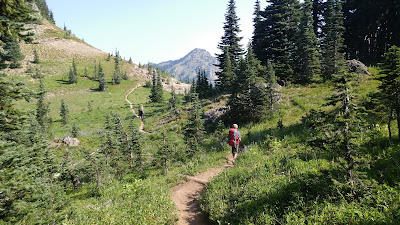--The Adventure Journal is reporting that, "After 10 years of planning, permitting, and fundraising, the Spearhead huts project is finally under way. BC Parks gave its final approval to begin construction of a system of three backcountry huts along the popular Spearhead Traverse in British Columbia’s Garibaldi Provincial Park, and The Alpine Club of Canada and the Spearhead Huts Society officially broke ground last week on the Kees and Claire Hut at Russet Lake." To read more, click here.
--Due to a fire, the Pacific Crest Trail is closed from White Pass north to Chinook Pass. To read more, click here.
Sierra:
--It appears that there was a fatality on Cathedral Peak this week. To read more, click here.
--Outside Online has a great report on the never-ending battle to keep the air clean from car pollution in Yosemite Valley. To read the article, click here.
--And speaking of Yosemite, there are several fires in and around the park and many roads are closed. To read more, click here.
--There is a large fire near Camp Nelson on Highway 190. This may be an issue for people trying to access the Needles. To read more, click here.
Desert Southwest:
--A canyoneering guide was injured this week in a fall near St. George, Utah. The St. George news is reporting, "A man was flown to the hospital Saturday morning after falling approximately 100 feet while rappelling in Birch Hollow. The man fell the day before, but by the time crews reached him, it was too late to get him out that day. When the incident was first reported Friday afternoon, Kane County Search and Rescue crews were shuttled to the man’s location via Classic Air Medical out of Kanab, Kane County Sheriff’s Chief Deputy Alan Alldredge said." To read more, click here.
--The LA Times is reporting that, "a 10,000 reward has been offered for information leading to the safe return of a couple reported missing in July in Joshua Tree National Park." To read more, click here.
Colorado:
--The Adventure Journal is reporting that, "It’s been a deadly summer on Capitol Peak, Colorado. In six weeks, five climbers have died on the technical fourteener. On Saturday, a 21-year-old climber fell to his death in the Knife Edge Ridge portion of the climb, apparently after attempting a shortcut descent that led to a 600-foot cliff. Pitkin County Sheriff’s Sergeant Jesse Steindler said the climber fell in the same area as an Aspen couple who died on the peak last week. All three bodies were found in a similar location, beneath the steep north face near Capitol Lake. Local authorities have yet to release the recently deceased climber’s identity." To read more, click here.
--An all women's adventure film festival will take place in Carbondale between September 14 and 17. To read more, click here. To see a trailer for the No Man's Land Film Festival, click below:
--Climbing magazine is looking for interns. To read more, click here.
Notes from All Over:
































